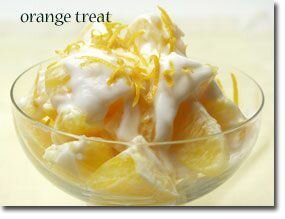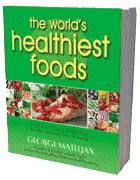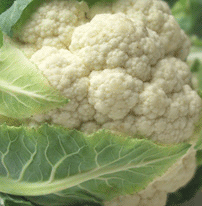
The George Mateljan Foundation, a not-for-profit foundation with no commercial interests or advertising, is a new force for change to help make a healthier you and a healthier world.
June 12, 2011
Forwarded from a friend? Sign up for your own copy of the
Weekly Newsletter and Healthy Food Tip and Recipe.
Weekly Newsletter and Healthy Food Tip and Recipe.
healthy food tip and recipe
Today's Recipe
If you don't know what to serve for dessert tonight ...
Try this tangy dessert tonight. One serving contains just 81 calories!
10-Minute Orange Treat

Prep and Cook Time: 10 minutes
Ingredients:
Serves 2
Printer Friendly Version of 10-Minute Orange Treat
In-Depth Nutritional Profile for 10-Minute Orange Treat
Healthy Food Tip
Canned light tuna, ordinarily made from skipjack tuna, actually poses a substantially lower risk in terms of mercury exposure than fresh yellowfin or albacore tuna. So this type of tuna-canned light tuna-is the type that's best for you to buy if you want to eat tuna relatively often, for example, about one meal per week. While canned light tuna might not provide you with more nutrients than fresh light tuna, it is still likely to be saving you nutrient supplies by allowing your body to avoid processing unwanted mercury.
A second type of fish that can have some surprising benefits when canned is salmon. Because canned salmon is often packed in its own oil, you may be getting the benefit of some extra omega-3 fatty acids when including this form in your Healthiest Way of Eating. Canned salmon also includes the bones (which are safe to eat since they soften during the canning process) and these bones can provide you with some added nutritional benefits as well. For example, a 3-ounce serving of salmon has over half the calcium found in an 8-ounce glass of cow's milk.
While considering these possible benefits, however, it is also important to remember that canning is a process that can take a toll on nutrients as well. There are usually two heating stages in the canning of fish. These stages are called "pre-treatment" and "retorting." During pre-treatment, before the fish is placed in the can, it is typically heated, often using steam (about 212°F/100°C) for one to eight hours, depending on the size of the fish. After the fillers, oils, brines, salts, or other components are added to the can along with the fish, there's a second round of heating, called retorting. Depending on the can size and other factors, about one to three hours are required at a temperature of about 240°F/116°C. The numbers above are typical for tuna and would vary for the canning of other fish.
Degree of heat and heat duration are key factors affecting nutrient loss not only in the canning of fish but with the cooking of all foods. If a fish has colorful pigments like carotenoids (part of the pre-vitamin A in salmon), the total amount will decrease with cooking. The amount of vitamin A retained in cooked salmon might appear to look higher than the amount found in raw salmon in some nutrition databases, but once you get the gram weight and edible portion sizes identical, you'll find the raw salmon to contain more. When you bring in the canning factor, you usually get another 15-35% reduction.
This two-fold heating process can take a significant toll on some of the nutrients found in fish. To help lessen the impact, some companies skip the pre-treatment process and place the fish into the can in fresh, raw form. When the cooking of the fish occurs only in the sealed can, the nutrient loss is less. Most of the companies that cook only in the can emphasize wild-caught fish and are focused on both environmental and health issues. You may need to search for this type of canned fish on the Internet because many stores do not routinely stock it. Although it may provide benefits, the cost of this type of canned fish may also be significantly higher.
Although I do not have specific data on canned versus fresh sardines, I would expect that additional calcium nourishment would also be the case for sardines as it is for salmon (and any other type of canned fish in which you see bones). However, since the bones of sardines are quite small and many people eat them even when cooking fresh sardines, the canned version might not turn out to have that much practical calcium advantage. Because tuna is not canned with bones, you should not group canned tuna together with canned sardines or canned salmon when you are thinking about calcium nourishment. But most of us will not be looking to tuna for our calcium supplies in the first place because a 6-ounce serving of freshly broiled tuna only provides us with about 35 milligrams of calcium (less than 5% of our daily requirement). In general, I believe that canned fish can serve as a satisfactory and convenient option to fresh fish, which is not always readily available.
If you have any questions about today's Healthy Food Tip Ask George Your Question
 How to Order The World's Healthiest Foods, Essential Guide for the Healthiest Way of Eating. See sample pages and find out how to place an order for our new book. The special offer of free shipping is still in effect. We are already getting wonderful feedback which we want to share with you, so we're posting it on the bottom of our home page. Enjoy the book and let us know how you like it. I have been using your book copy of The World's Healthiest Foods for several years (and i LOVE it!). - Laura
How to Order The World's Healthiest Foods, Essential Guide for the Healthiest Way of Eating. See sample pages and find out how to place an order for our new book. The special offer of free shipping is still in effect. We are already getting wonderful feedback which we want to share with you, so we're posting it on the bottom of our home page. Enjoy the book and let us know how you like it. I have been using your book copy of The World's Healthiest Foods for several years (and i LOVE it!). - Laura
If you don't know what to serve for dessert tonight ...
Try this tangy dessert tonight. One serving contains just 81 calories!

Prep and Cook Time: 10 minutes
Ingredients:
- 1/2 tsp grated lemon rind*
- 1/2 TBS fresh lemon juice
- 2 TBS honey
- 2-1/2 TBS low-fat yogurt
- 2 medium oranges
- Optional: Top with orange zest
- In a small bowl, whisk lemon rind, lemon juice and honey until the honey is incorporated.
- Add yogurt and whisk thoroughly.
- Peel and separate the individual sections of the orange. Be sure to remove the membrane covering from each section. Cut the sections into thirds crosswise. Place in 2 dessert bowls.
- Spoon sauce over the oranges.
Serves 2
Printer Friendly Version of 10-Minute Orange Treat
In-Depth Nutritional Profile for 10-Minute Orange Treat
Healthy Food Tip
Does canned fish (salmon or tuna) have any sort of nutritional benefit when compared to fresh fish?
While I always like to recommend foods as close to their whole, natural forms as possible, I do make exceptions when the more processed form of the food features more benefits. Tuna serves as a great example of this. Canned light tuna, ordinarily made from skipjack tuna, actually poses a substantially lower risk in terms of mercury exposure than fresh yellowfin or albacore tuna. So this type of tuna-canned light tuna-is the type that's best for you to buy if you want to eat tuna relatively often, for example, about one meal per week. While canned light tuna might not provide you with more nutrients than fresh light tuna, it is still likely to be saving you nutrient supplies by allowing your body to avoid processing unwanted mercury.
A second type of fish that can have some surprising benefits when canned is salmon. Because canned salmon is often packed in its own oil, you may be getting the benefit of some extra omega-3 fatty acids when including this form in your Healthiest Way of Eating. Canned salmon also includes the bones (which are safe to eat since they soften during the canning process) and these bones can provide you with some added nutritional benefits as well. For example, a 3-ounce serving of salmon has over half the calcium found in an 8-ounce glass of cow's milk.
While considering these possible benefits, however, it is also important to remember that canning is a process that can take a toll on nutrients as well. There are usually two heating stages in the canning of fish. These stages are called "pre-treatment" and "retorting." During pre-treatment, before the fish is placed in the can, it is typically heated, often using steam (about 212°F/100°C) for one to eight hours, depending on the size of the fish. After the fillers, oils, brines, salts, or other components are added to the can along with the fish, there's a second round of heating, called retorting. Depending on the can size and other factors, about one to three hours are required at a temperature of about 240°F/116°C. The numbers above are typical for tuna and would vary for the canning of other fish.
Degree of heat and heat duration are key factors affecting nutrient loss not only in the canning of fish but with the cooking of all foods. If a fish has colorful pigments like carotenoids (part of the pre-vitamin A in salmon), the total amount will decrease with cooking. The amount of vitamin A retained in cooked salmon might appear to look higher than the amount found in raw salmon in some nutrition databases, but once you get the gram weight and edible portion sizes identical, you'll find the raw salmon to contain more. When you bring in the canning factor, you usually get another 15-35% reduction.
This two-fold heating process can take a significant toll on some of the nutrients found in fish. To help lessen the impact, some companies skip the pre-treatment process and place the fish into the can in fresh, raw form. When the cooking of the fish occurs only in the sealed can, the nutrient loss is less. Most of the companies that cook only in the can emphasize wild-caught fish and are focused on both environmental and health issues. You may need to search for this type of canned fish on the Internet because many stores do not routinely stock it. Although it may provide benefits, the cost of this type of canned fish may also be significantly higher.
Although I do not have specific data on canned versus fresh sardines, I would expect that additional calcium nourishment would also be the case for sardines as it is for salmon (and any other type of canned fish in which you see bones). However, since the bones of sardines are quite small and many people eat them even when cooking fresh sardines, the canned version might not turn out to have that much practical calcium advantage. Because tuna is not canned with bones, you should not group canned tuna together with canned sardines or canned salmon when you are thinking about calcium nourishment. But most of us will not be looking to tuna for our calcium supplies in the first place because a 6-ounce serving of freshly broiled tuna only provides us with about 35 milligrams of calcium (less than 5% of our daily requirement). In general, I believe that canned fish can serve as a satisfactory and convenient option to fresh fish, which is not always readily available.
If you have any questions about today's Healthy Food Tip Ask George Your Question
What's New on the Home Page This Week
Breakthrough News
The Latest News about Cauliflower George's Q&A
Why do you include lean meat and poultry in the World's Healthiest Foods?  How to Order The World's Healthiest Foods, Essential Guide for the Healthiest Way of Eating. See sample pages and find out how to place an order for our new book. The special offer of free shipping is still in effect. We are already getting wonderful feedback which we want to share with you, so we're posting it on the bottom of our home page. Enjoy the book and let us know how you like it. I have been using your book copy of The World's Healthiest Foods for several years (and i LOVE it!). - Laura
How to Order The World's Healthiest Foods, Essential Guide for the Healthiest Way of Eating. See sample pages and find out how to place an order for our new book. The special offer of free shipping is still in effect. We are already getting wonderful feedback which we want to share with you, so we're posting it on the bottom of our home page. Enjoy the book and let us know how you like it. I have been using your book copy of The World's Healthiest Foods for several years (and i LOVE it!). - Laura Copyright © 2011 The George Mateljan Foundation, All Rights Reserved

No comments:
Post a Comment